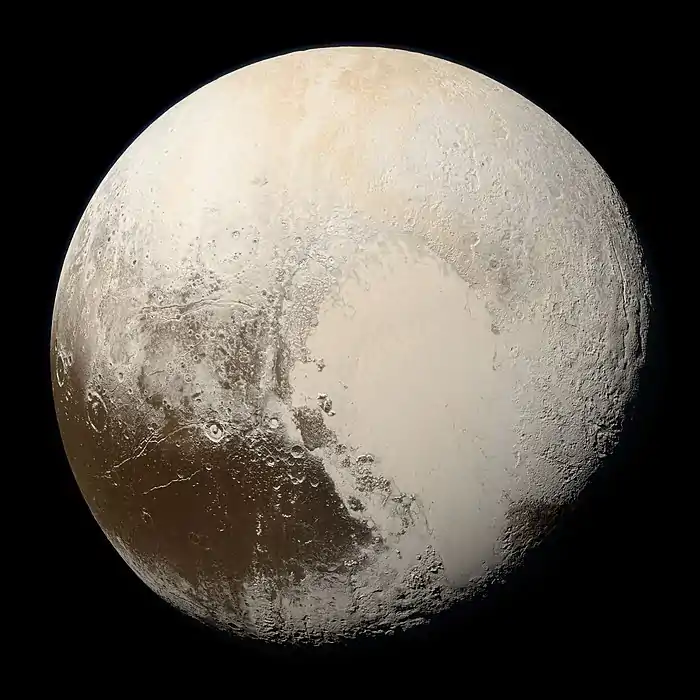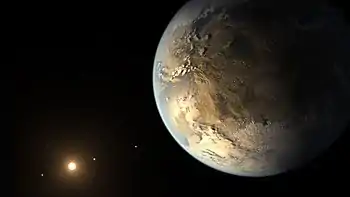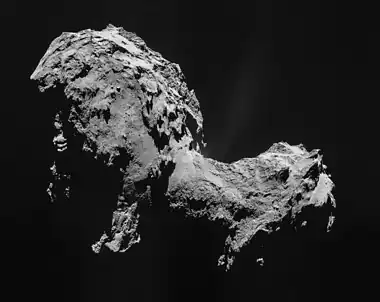 2014 EZ51 imaged by the Dark Energy Survey in March 2017 | |
| Discovery[1] | |
|---|---|
| Discovered by | Pan-STARRS 1 |
| Discovery site | Haleakala Obs. |
| Discovery date | 18 April 2010 |
| Designations | |
| (523692) 2014 EZ51 | |
| TNO[2][3] · SDO[4] · distant[1] | |
| Orbital characteristics[2] | |
| Epoch 17 December 2020 (JD 2459200.5) | |
| Uncertainty parameter 3[2] · 4[1] | |
| Observation arc | 10.16 yr (3,710 d) |
| Aphelion | 64.420 AU |
| Perihelion | 40.376 AU |
| 52.398 AU | |
| Eccentricity | 0.2294 |
| 379.29 yr (138,537 d) | |
| 269.18° | |
| 0° 0m 9.36s / day | |
| Inclination | 10.281° |
| 27.612° | |
| 330.11° | |
| Physical characteristics | |
Mean diameter | |
| 0.09 (assumed)[3] 0.11 (assumed)[6] | |
| 3.92[1][2] | |
(523692) 2014 EZ51, prov. designation: 2014 EZ51, is a large trans-Neptunian object in the scattered disc, approximately 700 kilometres (430 miles) in diameter. It was discovered on 18 April 2010, by the Pan-STARRS 1 survey at Haleakala Observatory, Hawaii, United States.[1]
Orbit and classification
2014 EZ51 orbits the Sun at a distance of 40.4–64.4 AU once every 379 years and 3 months (138,537 days; semi-major axis of 52.4 AU). Its orbit has an eccentricity of 0.23 and an inclination of 10° with respect to the ecliptic.[2] The body's observation arc begins with its official discovery observation at Haleakala in April 2010.[1]
Numbering and naming
This minor planet was numbered by the Minor Planet Center on 25 September 2018 (M.P.C. 111779).[7] As of February 2023, it has not been named.[1]
Physical characteristics
According to Michael Brown and the Johnston's archive, 2014 EZ51 measures 626 and 770 kilometers in diameter, based on an absolute magnitude of 4.2 and 3.8, with an assumed albedo of 0.10 and 0.09, respectively.[6][3] The MPC/JPL databases give an absolute magnitude of 3.92.[1][2] On 25 February 2019, a stellar occultation by 2014 EZ51 was observed in New Zealand. From these observations, a lower limit of 575 km was placed for its mean diameter.[5]
As of 2021, no physical characteristics have been determined from photometric observations. The body's rotation period, pole and shape remain unknown.[2][8][9]
References
- 1 2 3 4 5 6 7 8 "523692 (2014 EZ51)". Minor Planet Center. Retrieved 10 July 2021.
- 1 2 3 4 5 6 7 "JPL Small-Body Database Browser: 523692 (2014 EZ51)" (2020-06-14 last obs.). Jet Propulsion Laboratory. Retrieved 10 July 2021.
- 1 2 3 4 "List of Known Trans-Neptunian Objects". Johnston's Archive. 22 July 2017. Retrieved 9 October 2018.
- ↑ "List Of Centaurs and Scattered-Disk Objects". Minor Planet Center. Retrieved 9 October 2018.
- 1 2 Loader, B.; Hanna, W. (25 February 2019). "(523692) 2014 EZ51, 2019 February 25 occultation". occultations.org.nz. Retrieved 5 January 2020.
- 1 2 3 Brown, Michael E. "How many dwarf planets are there in the outer solar system? – "2014EZ51"". California Institute of Technology. Retrieved 10 July 2021.
- ↑ "MPC/MPO/MPS Archive". Minor Planet Center. Retrieved 9 October 2018.
- ↑ "LCDB Data for (523692)". Asteroid Lightcurve Database (LCDB). Retrieved 9 October 2018.
- ↑ "Asteroid (523692) 2014 EZ51". Small Bodies Data Ferret. Retrieved 9 October 2018.
External links
- Discovery Circumstances: Numbered Minor Planets (520001)-(525000) – Minor Planet Center
- (523692) 2014 EZ51 at AstDyS-2, Asteroids—Dynamic Site
- (523692) 2014 EZ51 at the JPL Small-Body Database
_(cropped).jpg.webp)



